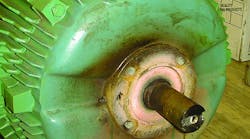Maintaining motors entails costs. Labor hours, test equipment, and bearing lubricant are the most obvious ones. And despite maintenance, motors sometimes fail anyhow. For example, a well-maintained motor might burn out due to an undetected voltage imbalance.
You can eliminate these costs by running motors to failure and then replacing them. The problem with that approach is when a motor fails unexpectedly, you get a process interruption until it’s replaced. The costs here can be enormous: lost revenue, paid operators with nothing to operate, generation of scrap, and corollary damage to production equipment.
These same problems crop up when motor maintenance is only partially done. For example, maintaining the motor without maintaining the motor system is why a well-maintained motor burns out due to undetected voltage imbalance.
Think through, then implement, a strategy based on keeping motors healthy rather than doing minimal maintenance.




